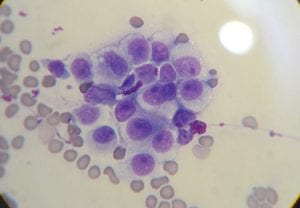Throughout the 20th and 21st centuries, human cancer has been one of the largest enemies of the medical community. A malignant cancer cell’s range of possible mutations and oncogenesis complicates the processes of diagnosis and prevention. Recent research shows, however, that the world’s oldest known type of cancer, Canine Transmissible Venereal Tumor (CTVT) lacks many of the qualities found in malignant cancer cells today. Murchison et al. (2014) detailed many of the qualities that distinguish this ancient cancer from its modern contemporaries (1).
As the name suggests, CTVT is exclusive to canines. It was described by a London practitioner in 1810 as “an ulcerous state, accompanied by a fungus excrescence” on the genitalia of dogs, wolves, foxes, and other canines (2). CTVT is one of only three cancers that are contagious; the infected cells spread from the genitalia of one host to another during coitus. This method of infection is unusual because cancers caused via pathogen are usually the result of a bacterium or virus. For example, certain variants of the Human Papilloma Virus (HPV) cause damage to the tumor suppressor protein p53, which in turn leads to a heightened risk of cervical cancer (3). Additionally, the tumors that arise from CTVT are not genetically related to the host dog, but instead are related to the original animal.
Murchison et al. first conducted chromosomal analysis using fluorescence in situ hybridization (FSIH), which uses fluorescent probes that bind to parts of a chromosome with which they show a high degree of sequence complementarity. The FISH process was conducted on samples 24T from Maningidra, Australia, and 79T from Franca, Brazil. Samples from both tumors showed incorrect numbers of chromosomes in relation to species, known as aneuploidy, to varying degrees. However, they also showed minimal divergence from one another with regard to subcloning. Different human cancer cells typically have a large number of subclones, which result from the positive environmental selection of newly acquired mutations (4). Thus, multiple cancer cells deriving from a common ancestor develop differing mutations based on their environment. The lack of such divergence between the two varieties of CTVT demonstrates that the tumor adapted to its environment more so than most human cancer cells.
Researchers also gained insight into the original host animal by reconstructing its phenotype from data from their two main samples. By analyzing genes at specific loci in CTVT, Murchison et al. determined that the founder animal was of medium to large size and had a mixture of dog and wolf alleles linked to domestication. They also found that the 24T and 79T samples held only a single X chromosome. This leaves the gender inconclusive, as aneuploidy means that the cell could have come from a male that lost its Y chromosome or a female that lost its other X chromosome.
The founder animal’s age was more easily calculated. By calculating the ratio of homozygous to heterozygous single-nucleotide polymorphisms in diploid regions and measuring approximately 400,000 variants of CTVT in 79T and 24T, the researchers estimated the total number of mutations to be around 500,000. From there, a “molecular clock” was used to calculate the age. Medullablastoma, a malignant brain tumor, is a human cancer with a mutation rate of 43.3 mutations per genome per year. It is also the cancer with the highest positive correlation between age and number of mutations, indicating a relatively high level of reliability (5). Using the mutation rate of medullablastoma as the standard, Murchison et al. calculated the age of CTVT to be around 11,368 years. The most recent common ancestor between the two samples is only 460 years old, however, which coincides with the historically high levels of expansion in the 16th and 17th centuries.
CTVT stands as the antithesis of modern cancer. Not only is it thousands of years old, but it is also contagious and bears only a minimal genetic resemblance to its host. It survives through parasitization of a group of animals that lives no longer than 15 years. Further research on the unusual qualities of CTVT may give researchers insight into new methods to inhibit the growth of more modern cancers.
References
1. Elizabeth P. Murchison et al.(2004), Transmissible Dog Cancer Genome Reveals the Origin and History of an Ancient Cell Lineage, (Science, January 2014), pp. 437-440
2. D. P. Blaine, A Domestic Treatise on the Diseases of Horses and Dogs (T. Boosey, London, 1810), pp. 161–162.
3. Martin Scheffner, B. Werness, J. Huibregtse, A. Levine, P. Howley, The E6 Oncoprotein Encoded by Human Papillomavirus Types 16 and 18 Promotes the Degradation of p53, (Cell, December 1990), pp. 1129-1136
4. Marco Gerlinger et al.(2012), Intratumor Heterogeneity and Branched Evolution Revealed by Multiregion Sequencing, (The New England Journal of Medicine, March 2012)
5. Ludmil B. Alexandrov et al.(2013), Signatures of Mutational Processes in Human Cancer, (Nature, August 2013), pp. 415-422
